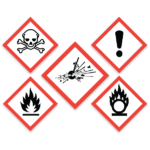
Road Salt Use and Safety
Every winter, road salt becomes a familiar sight on sidewalks, parking lots, stairways, and roadways. Whether used by businesses or at home, salt plays a vital role in reducing slips, falls, and vehicle accidents caused by ice. But safe and responsible use is essential. Too much salt can damage surfaces, harm pets, corrode equipment, and impact on the environment, while too little salt may leave walkways hazardous. Understanding how to use it correctly helps protect people, property, and the environment.
How does road salt work? Most road salt is sodium chloride. It lowers the freezing point of water, preventing ice from forming and helping melt thin layers of snow and slush. Salt is most effective when temperatures are around minus 10 degrees Celsius (14 degrees Fahrenheit) or warmer. When temperatures drop lower, salt becomes much less effective, and other products such as calcium chloride or sand may be needed.
Workplaces are responsible for maintaining the safety of sidewalks, loading docks, stairs, parking lots, and entrances for both workers and visitors. Salt is an important part of a winter safety program, but it should be used strategically. Clearing snow before applying salt is the first step. Salt should never be used as a substitute for shoveling or plowing because it works only on thin layers of ice. Applying salt evenly and avoiding piles reduces waste and prevents corrosion on metal structures, tools, and vehicles. Businesses should also store salt properly in covered containers to prevent contamination of soil and stormwater.
Slip and fall prevention is a major reason to use road salt. Even a small patch of ice can lead to serious injuries. Regular inspections of high-traffic areas, especially early in the morning or after freeze–thaw cycles, help ensure timely treatment. Workplaces should also choose the right de-icing product for the conditions. For extremely cold weather, calcium chloride or magnesium chloride may be more reliable than traditional salt.
Homeowners use salt primarily to prevent slips on driveways, walkways, and steps. Many people apply far more salt than needed. A small amount, spread evenly, is usually enough. Using a cup to measure helps avoid over-application. Just like in workplaces, shoveling first is the most effective way to control ice. Salt should be applied after clearing snow, not before.
Pets and children may be sensitive to salt. It can irritate paws, cause discomfort, and damage flooring when tracked indoors. Using pet-safe products or rinsing your pet’s paws after walks can help prevent irritation. Homeowners should also avoid spreading salt near lawns, gardens, and trees, as runoff can damage plants and alter soil chemistry.
One of the biggest concerns associated with road salt is environmental harm. When snow melts, salt travels into storm drains and local waterways, where it can stress freshwater ecosystems. High salt levels can affect drinking water sources, fish habitats, and roadside vegetation. Reducing salt use and switching to alternatives when appropriate helps limit these impacts. Sand can be used to add traction in colder temperatures. Some communities use salt brine solutions to reduce the total amount of salt needed.
Tips for safer and more responsible salt use:
• Shovel or plow first before applying salt
• Use only the amount needed and spread it evenly
• Choose the right de-icer for the temperature
• Store salt in a dry, covered container
• Sweep up excess salt once surfaces are dry
• Keep salt away from vegetation where possible
• Consider pet-safe and environmentally friendly options
• Inspect walking surfaces regularly in freeze–thaw cycles
Salt is a useful tool for preventing slips and keeping winter surfaces safe, both at home and in the workplace. With smart, measured use, businesses and homeowners can reduce hazards without causing unnecessary damage to the environment, infrastructure, or pets. Thoughtful winter maintenance keeps everyone safer through the coldest months of the year.
Following these tips can help ensure a safe winter season. Our team can help your business stay compliant and informed through our resources and products. Contact us to learn more about the ICC difference.
Stay up to date and sign up for our newsletter!
We have all the products, services and training you need to ensure your staff is properly trained and informed.
 SDS Services SDS Services |
 OSHA/WHMIS/GHS OSHA/WHMIS/GHSTraining Courses |
 GHS Pictograms GHS Pictograms |





